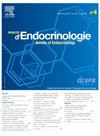第六章:原发性甲状旁腺功能亢进综合征。
IF 2.9
3区 医学
Q3 ENDOCRINOLOGY & METABOLISM
引用次数: 0
摘要
综合征型原发性甲状旁腺功能亢进有几个共同的特点:与散发性原发性甲状旁腺功能亢进相比,诊断年龄更小,常伴有或异时性多腺体受损伤,复发的可能性更高,与其他内分泌或内分泌外疾病有关,并提示常染色体显性遗传的家族背景。多发性内分泌肿瘤1型甲状旁腺功能亢进是最常见的综合征性甲状旁腺功能亢进。它通常在青少年和年轻人中无症状,但可能导致复发性结石和/或骨质流失。甲状旁腺功能亢进-下颌肿瘤综合征较少见,但通常立即出现症状,血钙水平较高,有时伴有非典型甲状旁腺瘤或甲状旁腺癌。多发性内分泌肿瘤2A型甲状旁腺功能亢进并不在临床表现的前沿,很少显示该疾病,并且通常表现为很少的症状。4型多发性内分泌瘤是最近才被发现的一种疾病,其中甲状旁腺功能亢进似乎发生得较晚,而且比以前的综合征不那么严重。在所有情况下,手术治疗的适应症和方式应在专家中心讨论。手术后复发的风险,特别是多发性内分泌肿瘤1型,需要长期监测。本文章由计算机程序翻译,如有差异,请以英文原文为准。
Chapter 6: Syndromic primary hyperparathyroidism
Syndromic primary hyperparathyroidism has several features in common: younger age at diagnosis when compared with sporadic primary hyperparathyroidism, often synchronous or metachronous multi-glandular involvement, higher possibility of recurrence, association with other endocrine or extra-endocrine disorders, and suggestive family background with autosomal dominant inheritance. Hyperparathyroidism in multiple endocrine neoplasia type 1 is the most common syndromic hyperparathyroidism. It is often asymptomatic in adolescents and young adults, but may be responsible for recurrent lithiasis and/or bone loss. Hyperparathyroidism-jaw tumor syndrome is less frequent, but often immediately symptomatic, with higher blood calcium levels, and is sometimes associated with an atypic parathyroid tumor or parathyroid carcinoma. Hyperparathyroidism in multiple endocrine neoplasia type 2A is not at the forefront of the clinical picture, rarely revealing the disease, and often manifests with few symptoms. Multiple endocrine neoplasia type 4 is a more recently described entity, in which hyperparathyroidism seems to occur later and be less severe than in previous syndromes. In all cases, the indications and modalities of surgical treatment should be discussed in an expert center. The risk of recurrence after surgery, particularly high in multiple endocrine neoplasia type 1, requires long-term monitoring.
求助全文
通过发布文献求助,成功后即可免费获取论文全文。
去求助
来源期刊

Annales d'endocrinologie
医学-内分泌学与代谢
CiteScore
4.40
自引率
6.50%
发文量
311
审稿时长
50 days
期刊介绍:
The Annales d''Endocrinologie, mouthpiece of the French Society of Endocrinology (SFE), publishes reviews, articles and case reports coming from clinical, therapeutic and fundamental research in endocrinology and metabolic diseases. Every year, it carries a position paper by a work-group of French-language endocrinologists, on an endocrine pathology chosen by the Society''s Scientific Committee. The journal is also the organ of the Society''s annual Congress, publishing a summary of the symposia, presentations and posters. "Les Must de l''Endocrinologie" is a special booklet brought out for the Congress, with summary articles that are always very well received. And finally, we publish the high-level instructional courses delivered during the Henri-Pierre Klotz International Endocrinology Days. The Annales is a window on the world, keeping alert clinicians up to date on what is going on in diagnosis and treatment in all the areas of our specialty.
 求助内容:
求助内容: 应助结果提醒方式:
应助结果提醒方式:


